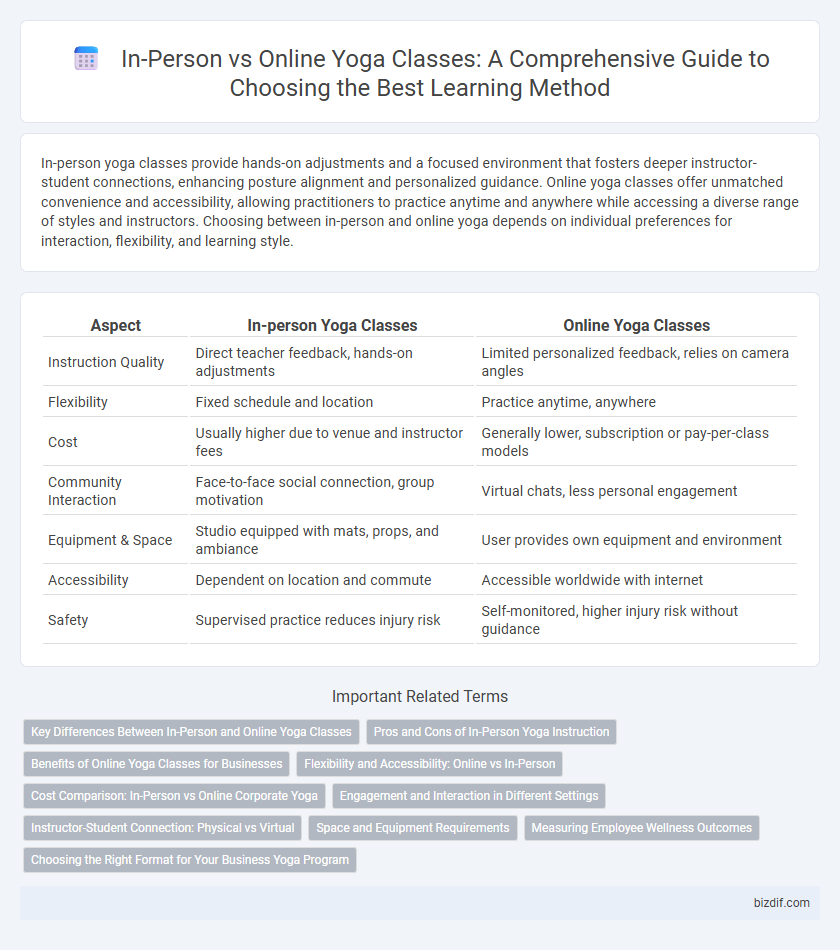In-person yoga classes provide hands-on adjustments and a focused environment that fosters deeper instructor-student connections, enhancing posture alignment and personalized guidance. Online yoga classes offer unmatched convenience and accessibility, allowing practitioners to practice anytime and anywhere while accessing a diverse range of styles and instructors. Choosing between in-person and online yoga depends on individual preferences for interaction, flexibility, and learning style.
Table of Comparison
| Aspect | In-person Yoga Classes | Online Yoga Classes |
|---|---|---|
| Instruction Quality | Direct teacher feedback, hands-on adjustments | Limited personalized feedback, relies on camera angles |
| Flexibility | Fixed schedule and location | Practice anytime, anywhere |
| Cost | Usually higher due to venue and instructor fees | Generally lower, subscription or pay-per-class models |
| Community Interaction | Face-to-face social connection, group motivation | Virtual chats, less personal engagement |
| Equipment & Space | Studio equipped with mats, props, and ambiance | User provides own equipment and environment |
| Accessibility | Dependent on location and commute | Accessible worldwide with internet |
| Safety | Supervised practice reduces injury risk | Self-monitored, higher injury risk without guidance |
Key Differences Between In-Person and Online Yoga Classes
In-person yoga classes offer direct hands-on adjustments and real-time personal feedback, enhancing alignment and technique through face-to-face interaction. Online yoga classes provide greater flexibility and accessibility, allowing practitioners to join sessions from any location and fit practice into varied schedules. The key differences lie in the level of personalized guidance, environmental control, and convenience each format delivers to yoga students.
Pros and Cons of In-Person Yoga Instruction
In-person yoga instruction offers personalized guidance, immediate feedback, and hands-on adjustments that enhance alignment and prevent injury, making it ideal for beginners and those seeking precise practice. The social interaction and structured environment of studio classes promote motivation and accountability but require travel and fixed scheduling, which can limit flexibility. However, higher costs and limited location options may pose challenges compared to more affordable and accessible online alternatives.
Benefits of Online Yoga Classes for Businesses
Online yoga classes offer businesses increased accessibility by reaching a broader and more diverse audience beyond geographical limitations, enhancing employee well-being programs. Cost-efficiency is significant as online formats reduce overhead expenses for physical space, equipment, and instructor travel, allowing budget reallocation to other wellness initiatives. The flexibility of on-demand scheduling promotes consistent participation, improving overall productivity and morale in the workplace.
Flexibility and Accessibility: Online vs In-Person
Online yoga classes offer unmatched flexibility, allowing practitioners to attend sessions anytime and from any location, which significantly enhances accessibility for individuals with busy schedules or limited mobility. In-person classes provide a structured environment with real-time instructor feedback and a dedicated space, fostering a deeper sense of community and accountability. Choosing between formats depends on personal preferences for convenience versus direct interaction and hands-on guidance.
Cost Comparison: In-Person vs Online Corporate Yoga
In-person corporate yoga classes typically involve higher costs due to venue rental, instructor travel, and equipment expenses, often ranging from $100 to $300 per session. Online corporate yoga reduces overhead by allowing instructors to conduct sessions virtually, lowering prices to approximately $50 to $150 per class. Companies seeking cost-effective wellness solutions increasingly prefer online formats for their flexibility and budget-friendly pricing.
Engagement and Interaction in Different Settings
In-person yoga classes foster direct engagement through hands-on adjustments and real-time feedback, enhancing students' physical alignment and personalized guidance. Online classes rely on digital interaction tools like chat and video, which can limit immediate corrections but offer flexibility and access to diverse instructor styles. The choice between settings affects the depth of student-teacher connection and overall class interactivity.
Instructor-Student Connection: Physical vs Virtual
In-person yoga classes foster a deeper instructor-student connection through physical presence, enabling immediate hands-on adjustments and personalized feedback that enhance posture and alignment. Virtual classes rely heavily on verbal cues and visual demonstrations, which can limit the instructor's ability to correct subtle misalignments and gauge student energy or engagement. However, online sessions offer flexibility and accessibility, allowing instructors to reach diverse students worldwide despite the lack of physical interaction.
Space and Equipment Requirements
In-person yoga classes demand a dedicated studio space equipped with mats, blocks, straps, and props to facilitate hands-on adjustments and group participation. Online classes offer flexibility by requiring minimal space and personalized equipment, often allowing practitioners to use household items as substitutes. Choosing between formats depends on the availability of physical space, access to specialized gear, and preference for tactile feedback during practice.
Measuring Employee Wellness Outcomes
Measuring employee wellness outcomes in yoga instruction reveals distinct advantages in in-person classes, where instructors can observe physical alignment and immediate feedback enhances engagement. Online classes offer flexibility and broader accessibility, but pose challenges in accurately assessing posture and real-time stress reduction. Utilizing wearable technology and structured self-reporting tools helps bridge the gap, providing quantifiable data on heart rate variability, mindfulness scores, and stress levels across both formats.
Choosing the Right Format for Your Business Yoga Program
Selecting the ideal format for your business yoga program hinges on understanding your audience's preferences, accessibility needs, and engagement levels. In-person classes foster direct interaction and immediate feedback, enhancing participant motivation and alignment corrections, while online classes offer flexibility and scalability, reaching a broader demographic with diverse schedules. Evaluating factors like workplace culture, technological resources, and participant goals ensures that your yoga program optimally supports employee wellbeing and productivity.
In-person Classes vs Online Classes Infographic

 bizdif.com
bizdif.com